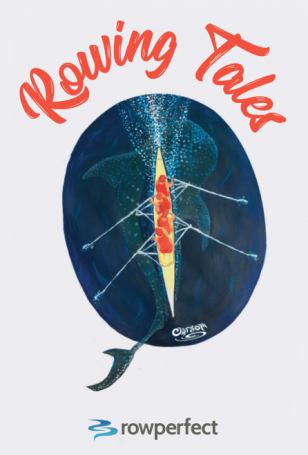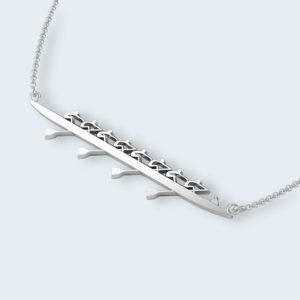Volker Nolte met me at the World Masters Games a year ago and told me this tale about how he was involved in the development of the (now banned) sliding rigger single scull. Here it is reproduced in full from the Rowing Tales book. Buy yours on Amazon, Kindle or from the Rowperfect store. At the end of the article I’ve included a video link to the 1982 Worlds showing the 1x final – all raced in sliding rigger singles.
I’m collecting stories now for the 2018 edition of Rowing Tales and so if you have a story to tell – please get in touch with me, Rebecca Caroe.
Volker Nolte’s Rowing Tale
One of the most memorable characters in the long history of world rowing is German-born Volker Nolte, recently retired professor of biomechanics at the University of Western Ontario, Canada. Prolific author, champion coach and mentor to a generation of rowing scientists, here he describes one of his many historic accomplishments.
Kolbe’s Last Chance
The rowing story that comes to my mind right away, because it was very special to me, was developing the sliding rigger single. I did not invent the sliding rigger. It was patented 100 years earlier, and it was tried several times over this 100 years. Literally, every ten years, someone tried to use it.
I think I was the first one who realized how the principle worked and that it for sure would be an advantage to use it. This happened during my studies for PhD when I developed a computer program where I could simulate certain situations. For example, if someone has longer legs or a heavier bodyweight, lighter bodyweight, and so on, and I also could change certain parameters on the boat, so I changedittotheslidingrigger. Itbecameimmediatelyclear from a theoretical point of view that it MUST be faster.
So, I went to my friend, Leo Wolloner, who was the foreman at Empacher Company – the boat builder in Germany. I told him about it, and he was not very keen of it. At first, he said, “Okay, this has been done already – 100 times. No one believes in it, blah, blah.”So, it took me about half a year to convince him, but he finally built a prototype boat.(The boat is now on display in the Rowing Gallery of the River Rowing Museum in Henley-on-Thames, England.)
It turned out, actually, that this would be the prototype of the wing rigger. He built one out of carbon fibre because his specialty was using composite materials. He was one of the first ones who did this in a very special way.
So, he built this boat, and of course, when you build a prototype, you do not know all the tricks that are involved. For example, the seat. He put in a normal seat fixed to the boat. I tested it and discovered that if you push off the foot stretcher, you will fall off the seat, so you have to build a seat that has a lip at the end that holds your butt so you cannot slide off. But then, of course, the seat has to be really formed to your butt because, if you do not do this, you get very quickly blisters. I went all through this–falling off the seat, getting blisters on my butt, and so on – and this was only one thing.
Then, of course, it needed to be constructed so that you could actually use a full slide and such things, so it took me some time to do this.
When it was ready, the top people didn’t want to use it. Literally, no one wanted to use it.
It was left to me to row the boat. I had already retired, so I started to get a little bit back in shape. But then I had to row in official [selection] races and did way better than I should have with my abilities. For example, I came third at the German Championship against Peter-Michael Kolbe and such top people. I was beating national team athletes. I used it in a 10-kilometre race for the national team, and I won in a record time and such things, and then people started to recognize it, but still no one wanted to row it.
It only happened when Peter-Michael Kolbe had lost for a whole year against another West German rower, Georg Agrikola. Kolbe’s last chance was to use the sliding rigger, and he did it at the Lucerne Regatta. Empacher built a boat for him because, I mean, he’s taller than I am and he needed a little bit better boat.
He used the boat in the race, and not only did he beat the West German guys, so he won the internal qualification for the World Championships, but he also faced Uwe Mundt, the very big talent from the East German group. The East Germans were bragging, “Oh, this will not work. Mundt will beat him easily,” and so on. In fact, Kolbe won, and this was psychologically devastating for Mundt. He never rowed a single again after that.
Then Kolbe rowed the boat at the world championships and won easily. This was 1981. In 1982, a sliding rigger boat was used by the first six athletes at the Worlds. Then, in 1983, the boat was used by eleven out of the twelve A and B semifinalists.
But then political opposition was building. The East Germans obviously hated it because a West German had beat the East Germans with better technology and such things, and they couldn’t leave this as is. So, they started to lobby against it. And then the other one, this was very interesting. Pertti Karppinen could not use a sliding rigger boat. He didn’t feel comfortable, so he actually went out of the single and into the double with his brother, but they never made it to world champions. They won the silver medal but never world champion. The Scandinavian countries started building a lobby, too.
It became political, and there were all kinds of dumb arguments that the boat would be too expensive and all this stuff. I tried to counter this. I gave a presentation at the FISA Coaches Conference, clarifying that the extra cost was minimal relative to the overall cost. Plus, after a while, you would actually see benefits from it, and one benefit was, of course, the wing rigger.
In the end, it was Kolbe who really rowed this boat very well, rowed it perfectly. He won the world championship in the boat in ‘81 and ‘83, but the lobbying by the Eastern Bloc and the Scandinavians was stronger, so FISA prohibited the boat starting in 1984. Of course, after it was forbidden, Kolbe came second at the ‘84 Olympic Games against Karppinen, who was a faster guy.
The interesting thing, again, and I said this at my presentation at the FISA Coaches Conference: if you prohibit technological development, you diminish our sport.
I also said that most likely in ten years everyone would row with wing riggers. Every boat builder actually built then a sliding rigger boat. The American boat builder, Van Dusen had one, Stämpfli had one, Hudson had one, the East Germans had one. All these boat building companies had their sliding riggers, but Van Dusen did the following thing: he had the foot stretchers attached underneath the wing and then, of course, the whole thing moving. When the sliding rigger was outlawed, he simply took the foot stretchers off the wing, put the foot stretchers in the boat, put the wing on top of the boat, and here we go. This was the prototype of the wing rigger.
Sure enough, nowadays everyone rows wing riggers because it’s such an easy construction compared to the side-mounted boat riggers. You don’t need shoulders anymore. It’s much easier to build and so on.
Extracted from Rowing Tales – the Anthology
Watch the 1982 World Rowing Championship single sculls final with Rudiger Reiche (East Germany) John Biglow (USA), Hans Svensson (Sweden), Georg Agrikola (West Germany), Vasily Yakusha (Soviet Union), Chris Baillieu (Great Britain).








